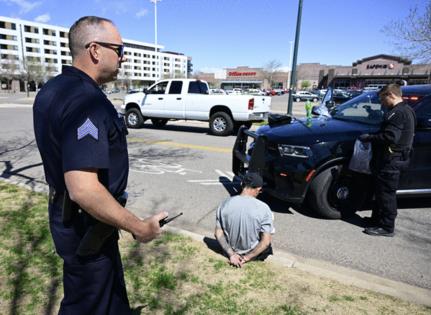Denver neighborhood crime doesn't always match city trends. Here's why
Published in News & Features
DENVER — Denver officials have heralded successful efforts to reduce homicides and gun violence in the city, but some Denver neighborhoods have higher rates of property and violent crime than the citywide average.
Denver’s crime statistics paint a nuanced picture of how public safety can change between neighborhoods and experts say there’s no one answer for why crime increases in some areas and not others — which means there’s also not a single solution to the problem.
“Denver has grown tremendously in the last 20 years,” said Stacey Hervey, an affiliate professor of criminal justice and criminology at Metropolitan State University of Denver. “Any time you add more homes, you’ll see more crimes – and you’re also seeing an increase in opportunity.”
Denver Police Department data break down incidents by neighborhood and type of crime, ranging from murder to public disorder.
Citywide, most violent crimes like sexual assault and murder decreased, leading to 91 fewer violent crimes in 2024 compared to 2023 for a total of 6,261.
But those trends don’t necessarily translate to every neighborhood. For example, while Denverites reported fewer aggravated assaults last year in the city overall, folks in neighborhoods like Barnum and Cherry Creek saw the opposite trend.
Assaults tripled in Cherry Creek, from nine in 2023 to 27 in 2024 and increased by almost 30% in Barnum, from 43 to 57, according to the Denver Police Department’s crime dashboard.
Property crimes in Denver followed a similar trend from 2023 to 2024, police data shows. While those crimes decreased by 17% citywide, the number and types of property crimes that were reported fluctuated widely — people stealing from cars dropped by 33%, but other thefts increased by 10%.
The different neighborhood trends in violent crimes also extend to property crimes — like the number of burglaries staying relatively flat citywide but increasing by 38% in Capitol Hill, from 110 in 2023 to 152 in 2024.
An increase in property crime doesn’t necessarily mean more violent crime will follow, Hervey said, because they’re often committed by different types of people.
“A lot of our violent crime rates are driven by gangs or young people, and they don’t traditionally do property crimes, which are often crimes of opportunity,” she said, like porch pirates or people stealing and pawning bicycles for quick cash.
There are plenty of theories about what influences crime rates, said Beverly Kingston, director of the Center for the Study and Prevention of Violence at the University of Colorado, Boulder.
One theory Kingston has studied in Denver neighborhoods is social disorganization theory, which suggests that community factors other than individual behavior contribute to crime. In a 2009 study, Kingston and two colleagues found the biggest factors that can predict criminal behavior in young Denverites were objective poverty and the belief that they had limited opportunities for the future.
Those factors can look like children and teenagers not having access to a high-quality education or extracurricular activities like summer camps.
“The kids are oftentimes not getting those developmental needs met by virtue of where they live and the resources that they have,” Kingston said.
For DPD Commander Brad Qualley and Sgt. Brian Husum, figuring out what’s causing spikes in neighborhood crime is less an academic exercise and more a regular part of the job.
Qualley oversees the District 4 precinct, which includes most of the city west of the South Platte River and south of West Sixth Avenue.
“For the most part, that district is primarily a working-class community with hardworking folks,” Husum said.
DPD officials often look at increases in 911 calls and crime data over the previous month to pinpoint areas of concern, Qualley said.
“I do think some of the trends or increases end up being area-specific and they’re usually short-lived because we’re able to identify who is responsible for that or they’ve moved on,” he said. “When they’re not short-lived, we start really focusing efforts on why that’s happening in a specific area.”
Some of those are “comfort areas,” Husum said — places like a home, apartment building or bus stop where people feel comfortable with criminal activity. Police also look for “corrupting locations,” or places where there’s a lot of crime, and try to determine what is allowing criminal behavior to flourish.
In one case, Husum’s team began investigating why stolen cars were repeatedly showing up at a bar near South Raritan Street and West Mississippi Avenue.
Police found that the bar owner was allowing drug and gun sales in the bar and arrested the people involved. A judge later ordered the bar closed, and crime dropped in the Athmar Park neighborhood as a result, Husum said. Department data show violent crime in Athmar Park is down 36% this year compared to the same time in 2024.
The entire operation took about 18 months.
“It’s not just finding and arresting criminals,” Husum said. “It’s changing the environment.”
For Kingston, the good news is that research shows that crime is not an inevitable reality in Denver. “Protective factors” like strong relationships with adults who care, connecting at school and having positive friends and hobbies or interests they’re passionate about and supported in are all linked to reduced crime rates.
“We know without a doubt that crime can be prevented,” she said. “Crime isn’t so random. There are reasons why it happens and we can do a lot to work upstream to prevent crime and intervene in the lives of people who are struggling and hurting and give them the support they need.”
Another comfort area was a large apartment complex in the 200 block of South Federal Boulevard that started seeing a high number of 911 calls, Qualley said.
Qualley and other District 4 officers started working on outreach with building managers, though it was hard to get a foothold at first because management kept changing. Eventually, the precinct was able to have regular meetings about how the department could help, whether through targeted enforcement or providing mental health or narcotics resources.
“I understand that there is frustration out there with residents, so I always ask them to actively get involved and ask them to come to the commanders’ advisory board we have monthly,” Qualley said. “It’s good to have that face-to-face.”
©2025 MediaNews Group, Inc. Visit at denverpost.com. Distributed by Tribune Content Agency, LLC.







Comments